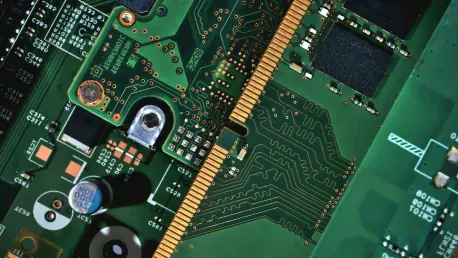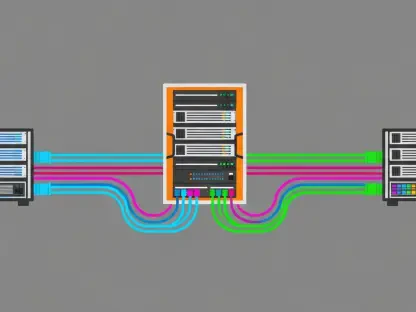Edge computing is revolutionizing how data is processed by bringing it closer to its source. This transformational shift from relying solely on cloud-based data centers to localized data handling is proving advantageous for various sectors. As we delve into its implications, we observe how industries are harnessing edge computing to enhance efficiency, security, and responsiveness.
Rapid Data Growth Demands Innovation
Exponential Data Generation
With the proliferation of digital devices, we are witnessing an exponential increase in data production. This surge in data necessitates innovative processing methods to manage and utilize information effectively. The constant influx of data from smartphones, sensors, and other Internet-connected devices is overwhelming traditional cloud-based data centers. This exponential growth in data generation is driven by the ubiquitous presence of digital technology in everyday life. The amount of data created and consumed globally is projected to reach unprecedented volumes in the coming years, making it imperative to adopt new approaches to data management and processing.
Conventional data centers, which have traditionally handled massive amounts of data at centralized locations, are increasingly struggling to cope with the deluge of information. This exponential data growth demands a paradigm shift towards more localized and efficient processing methods to ensure that information can be processed swiftly and effectively. The need for real-time processing of data calls for a solution that minimizes delays and optimizes the use of available resources, paving the way for edge computing to step in and address these critical challenges.
Cloud Computing Constraints
Traditional cloud computing, despite its benefits, is grappling with limitations. Issues related to latency, bandwidth, and reliability emerge as more devices are connected and data volumes expand. Cloud-based data centers, while offering centralized control and storage, often encounter performance bottlenecks and increased latency due to the physical distance between users and servers. As the network of connected devices continues to grow, these constraints become more pronounced, impacting the efficiency and responsiveness of cloud-based systems.
Bandwidth limitations pose another significant challenge for cloud computing. The continuous transmission of vast amounts of data to and from centralized servers can strain network resources and lead to congestion. This can result in slower data transfer rates and degraded performance, affecting applications that require real-time data processing. Additionally, the reliance on stable and high-speed internet connections for cloud computing raises concerns about reliability, particularly in situations where connectivity may be disrupted or unavailable.
The Shift to Edge Computing
Understanding Edge Computing
Edge computing addresses these challenges by processing data closer to its source. This paradigm shift allows for more efficient and swift handling of information, transforming data processing across the board. By bringing computation and data storage closer to the location where it is needed, edge computing reduces the need to transmit large volumes of data to centralized servers. This localized approach minimizes latency and enhances the responsiveness of applications, making it particularly well-suited for scenarios that demand real-time data processing.
The core concept of edge computing revolves around decentralizing data processing and storage. Instead of relying solely on distant cloud data centers, edge computing utilizes devices and equipment positioned near the data source, such as routers, gateways, and edge nodes. This distributed infrastructure enables quicker data analysis and decision-making, as well as the ability to perform critical tasks at the edge of the network. As a result, edge computing can significantly enhance the efficiency and effectiveness of data processing in various industries.
Advantages of Localized Processing
Key benefits of edge computing include reduced latency, lower bandwidth usage, and enhanced reliability. By minimizing the distance data travels, it enables quicker response times and decreased network strain. The proximity of data processing to the source ensures that critical information can be analyzed and acted upon almost instantaneously, which is crucial for time-sensitive applications. This ability to reduce latency is particularly advantageous for industries such as healthcare, manufacturing, and autonomous vehicles, where real-time decision-making is paramount.
Lower bandwidth usage is another significant advantage of edge computing. By processing and filtering data locally, edge devices can send only the necessary and relevant information to the cloud, reducing the amount of data transmitted over the network. This not only alleviates network congestion but also decreases the associated costs and resource demands. Enhanced reliability is achieved through the decentralized nature of edge computing, as localized processing can continue even if the connection to the central cloud server is interrupted. This ensures that critical operations remain functional and resilient in the face of connectivity issues.
Industry-Specific Impacts
Healthcare Enhancements
In the healthcare sector, edge computing facilitates rapid data processing, leading to faster diagnoses and personalized treatment plans. Medical data handled locally ensures timely and accurate responses essential for patient care. For instance, wearable health devices and sensors can continuously monitor vital signs and other health metrics, and edge computing allows for real-time analysis of this data. Immediate access to patient information enables healthcare providers to make informed decisions quickly, improving the quality of care and patient outcomes.
Edge computing also supports the integration of advanced technologies such as telemedicine and remote patient monitoring. By processing data at the edge, healthcare systems can deliver real-time consultation and diagnostic services, even in remote or underserved areas. This localized approach reduces the need for constant data transfer to central servers, ensuring that patient data remains secure and private. Additionally, the ability to analyze large volumes of medical data in real-time enhances the effectiveness of predictive analytics and preventive care, allowing healthcare professionals to identify potential health issues before they become critical.
Real-Time Solutions in Public Relations
Public relations benefit from edge computing through improved real-time media monitoring. The ability to quickly analyze and respond to breaking news fosters more dynamic and responsive PR strategies. Edge computing enables PR professionals to monitor social media platforms, news outlets, and other information sources in real-time, allowing them to identify emerging trends and critical developments as they happen. This immediate access to relevant data allows for timely responses and enables PR teams to craft accurate and effective messages tailored to the current situation.
Moreover, edge computing supports advanced analytics and sentiment analysis, helping PR practitioners gauge public opinion and sentiment more accurately. By processing data locally, PR teams can quickly identify positive or negative sentiments in social media posts, news articles, and online discussions. This insight empowers organizations to take proactive measures, address concerns, and amplify positive messages, ultimately shaping public perception and enhancing brand reputation. Edge computing’s ability to provide real-time insights allows PR professionals to stay ahead of the curve and maintain a competitive edge in a fast-paced media landscape.
Transforming Customer Experiences in Retail
Retail industries leverage edge computing to offer individualized shopping experiences. Real-time analysis of customer behavior enables retailers to tailor offers and services instantaneously. By processing data locally at the point of sale, edge computing allows retailers to track customer interactions, preferences, and purchasing patterns in real-time. This information can be used to deliver personalized recommendations, promotions, and discounts, enhancing the overall shopping experience and driving customer loyalty.
Edge computing also supports the implementation of advanced technologies such as augmented reality (AR) and virtual reality (VR) in retail environments. By enabling real-time data processing at the edge, retailers can create immersive and interactive shopping experiences that captivate and engage customers. For instance, AR-powered mirrors and virtual try-on solutions allow customers to visualize products before making a purchase, enhancing their confidence and satisfaction. Additionally, edge computing can optimize inventory management and supply chain operations, ensuring that products are available when and where customers need them.
Technological Integration and Synergy
The Role of 5G and AI
The advent of 5G technology and advancements in artificial intelligence (AI) significantly bolster the capabilities of edge computing. These innovations together amplify processing power and connectivity, driving further efficiencies. 5G networks offer ultra-fast data transfer speeds, low latency, and reliable connectivity, making them ideal for supporting edge computing applications. The increased bandwidth and reduced latency provided by 5G networks enable edge devices to process and transmit data more quickly, enhancing the overall performance and responsiveness of edge computing systems.
Artificial intelligence plays a crucial role in unlocking the full potential of edge computing. AI algorithms can be deployed at the edge to analyze data in real-time, enabling intelligent decision-making and automation. For example, AI-powered edge devices can detect anomalies, predict equipment failures, and optimize operations in various industries such as manufacturing, transportation, and healthcare. The combination of 5G and AI in edge computing creates a powerful synergy that drives innovation and efficiency, paving the way for new applications and use cases that were previously unattainable.
IoT and Edge Computing
Edge computing optimizes Internet of Things (IoT) devices by enhancing their operational efficiency. Processing data on the edge reduces their reliance on constant internet connections while extending device battery lives. Edge computing enables IoT devices to perform data processing tasks locally, allowing them to operate independently and make real-time decisions without relying on centralized cloud servers. This localized processing minimizes the need for continuous data transmission, reducing the strain on network resources and enhancing the efficiency of IoT ecosystems.
In addition to improving operational efficiency, edge computing also enhances the security and privacy of IoT devices. By processing sensitive data locally, edge devices can reduce the amount of information transmitted over networks, mitigating the risk of data breaches and unauthorized access. This decentralized approach ensures that IoT devices can function securely even in environments with limited or intermittent connectivity. The integration of edge computing with IoT systems further extends the capabilities of connected devices, enabling them to deliver smarter, more responsive, and energy-efficient solutions across various applications.
Security and Performance
Enhanced Security Measures
Processing data locally lowers the volume of sensitive information transmitted over networks, enhancing security. However, the decentralized nature of edge devices introduces new security challenges that must be managed with robust measures. Localized data processing reduces the exposure of sensitive information to potential cyber threats during transmission, mitigating the risk of data breaches and unauthorized access. Encryption, authentication, and access control mechanisms are essential to protect data at rest and in transit, ensuring that only authorized entities can access and process the information.
To address the security challenges posed by the decentralized nature of edge computing, organizations must implement comprehensive security strategies that encompass physical, network, and data security measures. Regular updates and patches are critical to ensuring that edge devices remain protected against emerging threats and vulnerabilities. Additionally, the use of secure communication protocols and data anonymization techniques can further enhance the security and privacy of localized data processing. By adopting a proactive and holistic approach to security, organizations can mitigate the risks associated with edge computing and safeguard their data and systems.
Edge AI for Immediate Response
Edge AI signifies running AI algorithms on local devices, empowering them to perform tasks like facial recognition and intelligent voice command processing. This capability ensures faster and more private user interactions. By deploying AI models at the edge, devices can analyze data and make decisions in real-time, without the need to transmit information to centralized servers. This localized approach not only reduces latency but also enhances the privacy of user data, as sensitive information remains on the device and is not transmitted over networks.
Edge AI is particularly beneficial for applications that require immediate responses and low latency, such as autonomous vehicles, smart home devices, and industrial automation. For example, edge AI-enabled cameras can perform facial recognition and object detection in real-time, providing instant security alerts and notifications. Similarly, smart speakers and voice assistants equipped with edge AI can process voice commands locally, ensuring faster and more accurate responses to user queries. The ability to run AI algorithms on edge devices opens up new possibilities for creating intelligent and responsive systems that enhance user experiences and drive innovation across various industries.
The Hybrid Edge-Cloud Approach
Complementary Systems
Edge computing complements rather than replaces traditional cloud computing. Immediate-response tasks are managed at the edge, while complex processing can still be offloaded to the cloud, suggesting a hybrid approach is optimal. This hybrid architecture leverages the strengths of both edge and cloud computing to create a more flexible and efficient data processing model. By distributing computational tasks between edge devices and central cloud servers, organizations can optimize resource utilization and achieve a balance between low-latency processing and high-powered analytics.
The hybrid edge-cloud approach is particularly advantageous for applications that require a combination of real-time processing and extensive data analysis. For instance, smart grid systems can use edge computing to monitor and control energy distribution in real-time, while leveraging cloud computing for predictive maintenance and demand forecasting. This complementary relationship allows organizations to harness the benefits of both localized processing and centralized data management, ensuring that critical operations remain efficient, scalable, and resilient.
Implementing Edge Computing
Businesses should start edge computing with use cases that benefit from low latency and high privacy. Pilot projects can demonstrate the value of edge computing and facilitate its integration with cloud services. Identifying specific applications where edge computing can provide immediate benefits, such as real-time data analysis, predictive maintenance, or personalized customer experiences, is crucial for successful implementation. By starting with targeted use cases, organizations can validate the effectiveness of edge computing and build a strong foundation for broader adoption.
Collaboration with experienced technology partners and leveraging existing edge computing platforms can also streamline the implementation process. Major providers offer turnkey solutions that simplify the deployment and management of edge computing infrastructure, enabling businesses to focus on their core operations. Additionally, organizations should establish a clear roadmap and timeline for scaling their edge computing initiatives, ensuring that they can gradually expand their capabilities while maintaining alignment with strategic goals. Effective implementation requires careful planning, continuous evaluation, and a commitment to leveraging edge computing to drive innovation and efficiency.
Edge computing is indeed a significant leap forward in computing infrastructure, impacting numerous sectors and presenting substantial practical benefits. It is a technological evolution addressing burgeoning data processing requirements and opening doors to new innovations across industries.
Conclusion: Embracing the Future of Data Processing
Edge computing is significantly transforming the way data is processed by moving the processing tasks closer to the data source itself. This innovative shift from the traditional, centralized cloud-based data centers to more localized data handling and processing is proving to be highly beneficial for various industries.
By bringing data processing closer to where data is generated, edge computing enables faster response times and reduces the latency issues inherent in cloud computing. This is particularly advantageous in sectors where real-time data processing is critical, such as healthcare, autonomous vehicles, and manufacturing. For example, in autonomous vehicles, the ability to process data locally ensures quicker decision-making, which is essential for safety.
Additionally, edge computing enhances security by keeping sensitive data on-site rather than transmitting it to a central cloud server, thus reducing the risk of data breaches. Industries are also leveraging this technology to improve operational efficiency by minimizing reliance on network connectivity, which can be unreliable in certain conditions.
Overall, edge computing is reshaping the landscape of data management and processing, offering improved efficiency, heightened security, and faster responsiveness, which are essential in our increasingly data-driven world.









